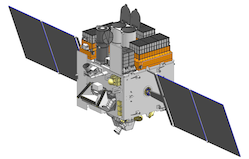
The AstroSat mission is the first
dedicated Indian asrtonomy mission. It is equpped with instruments to observe
over a wide span of the electromagnetic spectrum, including visual,
near and far ultraviolet, and X-ray wavelengths. The satellite was launched
on September 28, 2015 from the Satish Dhawan Space Centre, in Sriharikota,
India. AstroSat was placed in a 650 km altitude orbit with a 6 degree
equatorial inclination. First light occured in early October, 2015.
The initial mission plan calls for a five year duration, which is likely
to be extended.
AstroSat carries several astrophysics instruments from ultraviolet
to hard X-ray wavelengths. These include:
- The Ultraviolet Imaging Telescope (UVIT), a pair of twin telescopes
covering wavelengths
350–600 nm (near UV and optical) and 130–300 nm (far UV)
- Large Area Xenon Proportional Counter (LAXPC), a trio of proportional
counters for hard X-rays in the
energy range of 3–100 keV. The combined counters provide an
effective area of 8000 cm2 at 10 keV.
- Soft X-Ray Telescope (SXT) for soft X-rays in the energy range
0.3–10 keV. SXT has a set of conical foil mirrors and a CCD
detector with an effective area of 120 cm2 at 1 keV. The CCD
array is thermal-electrically cooled to -80°C.
- Cadmium-Zinc-Telluride Imager (CZTI) for hard X-rays in the energy range
20–200 keV. CZTI has a 4.6° field of view and a 490 cm2
effective area below 100 keV. The top of the instrument is covered by a
Tantalum plate
with a coded aperature mask, allowing image reconstruction from the
shading pattern. The detector has four quadrants with 16 detectors in each
quadrant, with each detector having 256 pixels with a cross-section of
2.5 mm x 2.5 mm, with
timing accuracy of 20 microseconds. The detector elements are made of
CdZnTe with a spectral accuracy of 11% at 60 keV.
- Scanning Sky Monitor (SSM) for survey of sky in the energy range
2–10 keV. The SSM instrument uses a set of three one-dimensional
position-senstive proportional counters equipped with coded masks. SSM is
mounted on a single platform capable of being rotated to provide
different orientations.
- Charge Particle Monitor (CPM) to detect high energy particles, putting
instruments in a temporary safe hold in event of extreme radiation.
Although AstroSat’s low inclination orbit avoids the most intense
areas of the South Atlantic Anomaly, the satellite does encounter
the SAA: CPM monitors to ramp down
high voltage systems to prevent instrument damage
AstroSat is performing simultaneous multi-wavelength monitoring of
intensity variations for a broad range of cosmic sources. This includes
monitoring the X-ray sky for new transient sources, performing sky surveys
in hard X-ray and UV wavelengths, and collecting broad-band spectroscopic
data on X-ray binaries, active galactic nuclei, supernova remnants,
galaxy clusters, and stellar coronae.